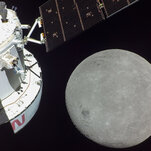
NASA Picks Jeff Bezos’ Blue Origin for Artemis Moon Mission
On the second try, Jeff Bezos and his rocket company have won a contract to take NASA astronauts to the surface of the moon.
NASA announced on Friday that it had awarded a contract to Mr. Bezos’ company, Blue Origin, to provide a lunar lander for a moon mission that is currently scheduled to launch in 2029.
The mission, Artemis V, is another key piece of NASA’s Artemis program, which is to send astronauts back to the moon as part of an effort to explore the south pole region. Astronauts are to land on the moon in a vehicle built by SpaceX for the Artemis III and IV missions.
”We want more competition,” Bill Nelson, the NASA administrator, during the event on Friday at NASA headquarters in Washington on Friday. “It means that you have reliability. You have backups.”
NASA will pay $3.4 billion to Blue Origin, and John Couluris, Blue Origin’s vice president for lunar transportation, said the company was contributing “well north” of that amount to the development effort.
The winning of the contract could start a promising rebound year for Blue Origin after a number of delays and setbacks. That includes the failure of one of its New Shepard vehicles, which travel to space but not to orbit, during a launch last September that carried experiments but no passengers. Blue Origin has identified the cause and hopes to resume New Shepard flights involving both space tourists and scientific cargo later this year.
And some hardware manufactured by Blue Origin might finally be used on an orbital mission in the coming months. The company built engines for the booster stage of the Vulcan rocket being developed by the United Launch Alliance, a joint venture of the aerospace giants Boeing and Lockheed Martin.
Blue Origin might also provide some public glimpses of New Glenn, a much larger rocket that is to launch payloads to orbit.
For the lunar lander contract, Blue Origin, collaborating with other aerospace companies including Boeing and Lockheed Martin, beat a second team led by Dynetics, a defense company based in Huntsville, Ala. Dynetics, a subsidiary of Leidos of Reston, Va., had enlisted the help of the aerospace contractor Northrop Grumman for its bid.
Blue Origin and Dynetics were disappointed losers in 2021 when NASA awarded a $2.9 billion contract to SpaceX to build a variation of its giant Starship vehicle that would land astronauts on the moon for the first time in more than half a century.
The two companies protested the decision, especially because NASA officials originally aimed to award two contracts.
That would have paralleled successful efforts by NASA that turned over to private companies the transportation of cargo and crew to the International Space Station. Competition helps drive costs down and provides redundancy if something goes wrong, agency officials have said.
But in giving just one award to SpaceX, NASA officials said there was not enough money in their budget for a second lander. SpaceX’s $2.9 billion bid was the lowest bid by far. Blue Origin’s proposed design had a price tag of $6 billion, and the one offered by Dynetics was even more expensive.
The federal Government Accountability Office rejected the protests of the two companies. Blue Origin then sued in federal court and again lost.
Last year, after winning a larger budget from Congress, NASA announced a competition for a second lunar lander. Dynetics and Blue Origin decided to compete again, although there was some shuffling of the companies participating in the efforts. Northrop Grumman, which was part of Blue Origin’s original proposal, switched to the Dynetics team.
Blue Origin added to its team Boeing; Astrobotic, a small Pittsburgh company that is developing robotic lunar landers; and Honeybee Robotics, a space technology company that Blue Origin bought last year.
The Blue Origin lander, which is designed to take two astronauts to the moon’s south pole region, will not get to the moon for quite a while.
SpaceX’s initial $2.9 billion contract was to provide the lander for the first moon landing during Artemis III, which is currently scheduled for late 2025 but is likely to slip to 2026 or later. In November, NASA exercised a $1.15 billion option in that contract for SpaceX to provide a lander for Artemis IV as well, a mission that is scheduled for 2028.

